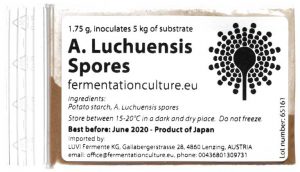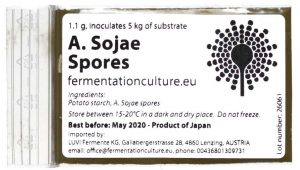Soy Koji Spores
From: 6,00€
This strain has been specifically bred to grow well on soybeans.
It has good fragrance, medium amount of amylase, but strong proteolytic power, which is perfect for hatcho miso.
Growing Koji on soybeans is a bit advanced, and we do not recommend to attempt this as your first koji. It is better to start with rice to get a good feeling for the process.
It is best to soak the soybeans for at least 12 hours. Drain them, and then steam them in a pressure cooker for 1 hour (if you dont’t have a pressure cooker, steam the beans in a normal steamer for 3 hours).
After steaming, make sure that the beans are not too wet. If they are too wet, Bacillus Subtilis will take over (Natto bacteria), which will result in slimy beans that smell like ammonia.
In order to avoid that, you can either dry them with a hairdrier a bit, or you could also dust them with starch/toasted flour, which will soak up any excess moisture.
| Weight | 0,8 g |
|---|---|
| Amount | For 5 kg, For 50 kg, For 200 kg |











Dario Marxer (verified owner) –
Sebastian Kihlstrand (verified owner) –
Michael Primes (verified owner) –
Guillermo Revenga (verified owner) –
ΖΑΧΑΡΟΠΟΥΛΟΣ ΝΙΚΟΛΑΣ (verified owner) –
I made an order which was not tracked and got lost during the Christmas season. fermentation culture was so kind to send another parcel free of charge. As far as the products go there is nothing to say except they seem perfect. I haven’t tried yet the shoyu and miso I made since they are not ready yet but I can clearly see the difference between previous spores I have used
Vanessa Urben (verified owner) –
Ludwig Ringbom (verified owner) –
Maria Crete (verified owner) –
Very good product. Thanks
Claudia Liliana Quiroz Ramirez (verified owner) –
elena galvagni (verified owner) –
Alex (verified owner) –
I use this on broad beans (aka fava beans) to make red oil doubanjiang (loosly based on this recipe: https://www.chinasichuanfood.com/doubanjiang/) and it works quite well. You do need to be careful not to inoculate too long — it’s a trickier fermentation than koji rice. Competitor molds and bacillus like to get started around 48h, and I’ve lost a few trays to it.
The key, I’ve found, is to think of it as a 36 hour process — you get 36 hours to grow koji, at which point you need to end the fermentation. The goal is that the koji get as far as it can in that time. This is a good koji for doing that with as it grows quickly on broad beans. I also use 2-3x the recommended amount of spores to give it every advantage I can. The recipe I link says to wait for it to sporulate, but I am not sure it’s necessary.
I made my first batch 6 months ago using this spore line, and have already eaten some of it, so I know it works. I have a bunch more batches in various stages.